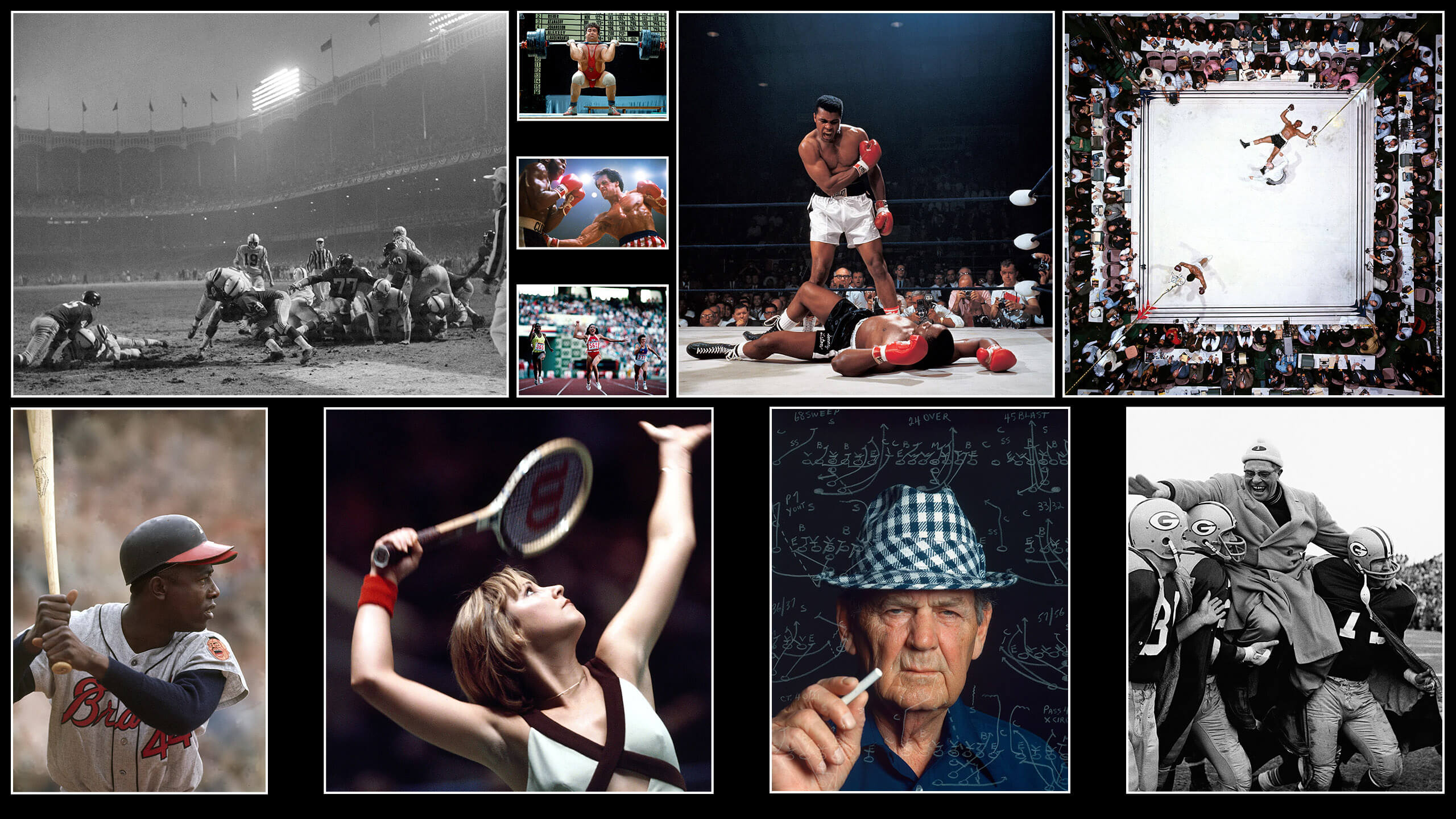“I’ve done four or five pictures that people will remember.” -Neil Leifer
Opening photo, top row l-r: 1958 NFL Championship game at Yankee Stadium, Column top-down: USSR weightlifter Vasily Alexeyev 1970, Sylvester Stallone and Mr. T on set for Rocky III 1982, Florence Griffith-Joiner 1988 Olympic games, Muhammad Ali’s first-round knockout of Sonny Liston 1965 and aerial view of the Ali-Liston knockout.
Opening photo, bottom row l-r: Hank Arron 1964, Chris Evert 1977, Alabama head coach Paul Bear Bryant 1979 and Green Bay Packers head coach Vince Lombardi 1969
60-year career
Sports photographer and filmmaker, Neil Leifer’s photographs have been appearing in Sports Illustrated, Time, and LIFE magazines since 1960. He has made over 200 covers for Sports Illustrated, People and Time.
Lower East Side
Neil Leifer grew up poor in a very tough neighborhood where kids either went up the river to Sing Sing Prison or found a tuition-free college or a scholarship. He played basketball in the gym. There were things for kids to do to keep them off the streets and out of trouble.
Camera club
One of the things that Neil Leifer found was photography as one of those things where he could learn something new that would be useful later in life. He was thirteen.
“Well, they had a camera club and I started taking pictures,” Neil Leifer remembers. “Nobody could afford a camera or film; they donated cameras and film.”
Why shoot sports?
“I began shooting sports pictures because it was combining two things that I liked,” he said. “The idea of getting the best seat in the house at an event and doing something I enjoy doing, which was taking pictures, the combination was perfect. It just was a lucky coincidence because the word business or career didn’t exist in my vocabulary as a 14-year-old.”
Getting that best seat
In the late 1950s, the Americans with Disabilities Act (ADA) had yet to be passed. There was no access into the stands for wheelchairs.
Neil Leifer tells the story of his photo of the “The Greatest Game Ever Played” in the Bronx in 1958. “The only place you could actually bring these wheelchairs was right on the field along the outfield wall. Well, that put you on the field.
“Once they got into the stadium, they realized that the worst seat in the house is on the field, particularly when you’re stuck in one end zone unless you’re trying to shoot pictures,” Neil Leifer explained. “I was the only one trying to shoot some pictures. Yeah, it took half the game totally out of reach.
Actually, it took four-fifths of the game because the only camera I had then was this — I used to call it a poor man’s Rolleiflex — a Yashica Mat with a normal lens. If I had the money to get a medium telephoto, which I dreamed of getting, I would never had shot this picture, which is another luck factor because I just wasn’t creative enough to think I would’ve filled the frame with the play.”
“Instead, my picture, of course, shows the whole ambiance, the whole mood at Yankee Stadium. Late in the afternoon, with the sudden death, you had, in film parlance, the magic hour setting in. It was beautiful,” he said. “You had the lights of the stadium and a little bit of haze and it was wonderful. And there right in front of me, you had every player on the field because I couldn’t come in close enough with the lens. And what happened was, of course, Ameche scored the winning touchdown right in our end zone, and at that point, I was on the goal line exactly ten yards in front of him, and he came right at me.” Opening photo, top row, first image.
The greatest sports photo
“I’m going to preface this by saying I’ve never met a good sports photographer or photographer who didn’t have a healthy ego, so when I use the word luck, I am not being modest. Luck in sports photography is everything and what separates the really top sports photographer from the ordinary is that when he or she gets lucky, they don’t miss. That is the key. But you have to be lucky,” Leifer said. “For example, my best-known picture, Muhammad Ali standing over Sonny Liston, the guy between Ali’s legs was an old established boxing photographer, great photographer Herb Scharfman. I don’t care how good he was that day; he was in the wrong seat. He was looking up at Ali’s rear end and that’s the only picture he could get. I was obviously in the right seat, but what matters is I didn’t miss.” Opening photo, top row, second large image.
Behind the scenes
This video has Neil Leifer explaining how he made the photo of Muhammad Ali standing over Sonny Liston.
Sources: Neil Leifer, The Post Game.
Read stories of inspiration photographers in On Photography.
Source link




Leave a Reply